Breaks are rare in this crazy season of football, as the EFL Cup arranged fixtures in this midweek to see who could enter the quarter-finals. After beating Bournemouth in the previous round, Manchester City faced Burnley at Turf Moor. Pep Guardiola sent a strong squad to restore players’ confidence, which was important given the heavy loss last Sunday against Leceister City.
Burnley also welcomed several players backed to the team, but keeping some key players on the bench. They tried to go aggressive but failed to stop City from creating chances, but Bailey Peacock-Farrell’s strong hand has helped the team to narrow the scoreline to a margin of three goals.
This tactical analysis the tactics of Sean Dyche and Guardiola, introducing the approaches that helped the Citizens to win comfortably away from home.
Lineups
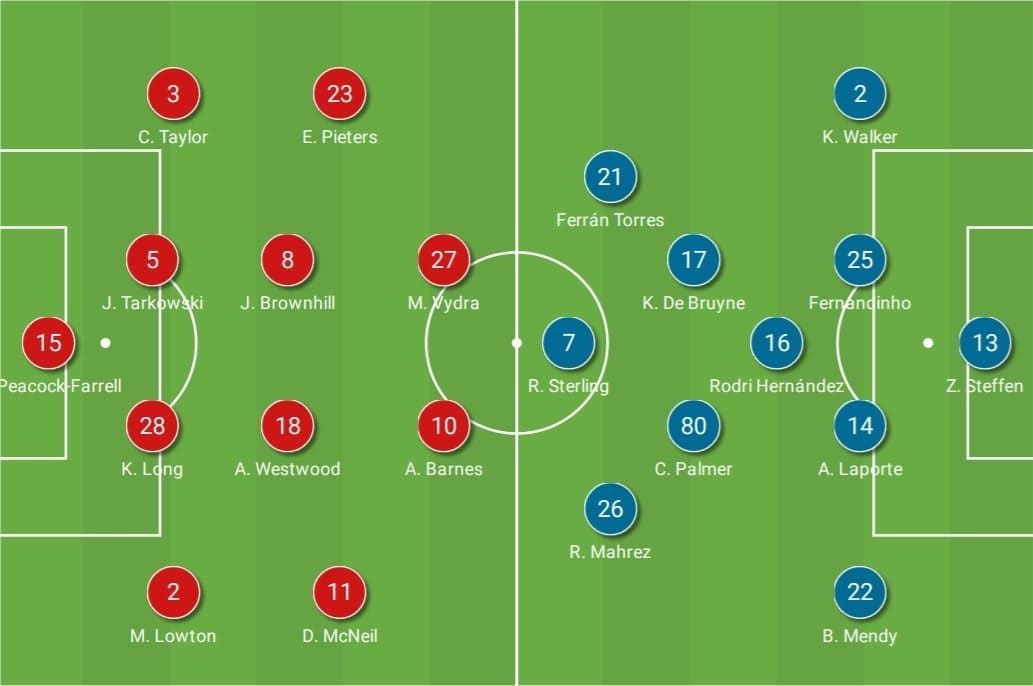
Burnley kept Phil Bardsley and Chris Wood on the bench, the remaining are experienced veterans of English football. Without Ben Mee, Kevin Long was the partner of James Tarkowski.
Manchester City had a young blue – Cole Palmer starting at the midfield with Kevin De Bruyne and Rodrigo Hernández. Ferrán Torres earned his second start of the season. Raheem Sterling played as the striker given Gabriel Jesus and Sergio Agüero were injured.
Build-up and bypassing the press
Burnley were always more aggressive, looking to press the opponent at their front foot on home soil. Leading by the strikers, the press was triggered by return passes or a short goal kick, mostly involving five players. When the strikers split apart because of the wide positionings of centre-backs, a midfielder would step up to cover central spaces, where was the key emphasis of Burnley’s defence. Dyche wanted his team to control central areas, even at the expense of leaving wide areas opened.
However, Burnley were unable to deal with the wide shape of City. Pep’s men made the pitch as wide as possible to create spaces, stretching horizontal gaps and creating isolations of opponents. When confronting a press, City fully capitalised on spaces behind the midfield to harm the opposition. Apart from Sterling operating as a “false-9”, the wingers also came inside narrowly to shake of the full-backs, receiving the ball without pressure. This spacing was the key to break the press, as highlighted in the below image.
Sterling and Torres could offer the dynamism given their pace. These two were keen to drop (or move) into the highlighted region, as well as making runs to search the attacking depth. Riyad Mahrez was more like a “false-winger” who roam his position, also exploiting these spaces to play the killer balls.
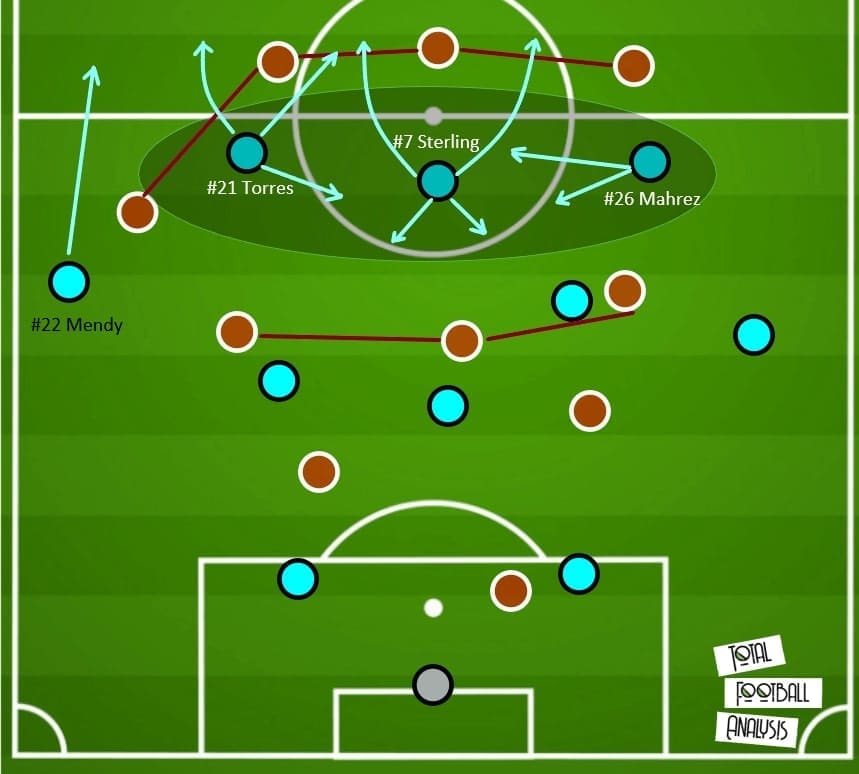
Before explaining how City were being able to access the highlighted (above) region, we have to understand their routes to break the first wave of pressure. As mentioned in the above analysis, City placed a pair of wide full-backs to make the pitch big in the first phase. Also, they could drop De Bruyne or Palmer to invite pressure at the central zone, opening more free spaces at the wide zones. An important part was leaving the front three engaged with the backline, providing the offensive height, keeping the defence occupied.
In those cases, the kicking ability of the keeper would be important. Ederson was not starting this game, instead, it was the American international – Zack Steffen. Steffen was also good at passing, completing 28 of his 32 passes. Most distributions were delivered to the wide zones as a resort to evade from the player abundance zone.
In this example, his accurate pass to Benjamin Mendy helped City to develop the attack at free spaces.
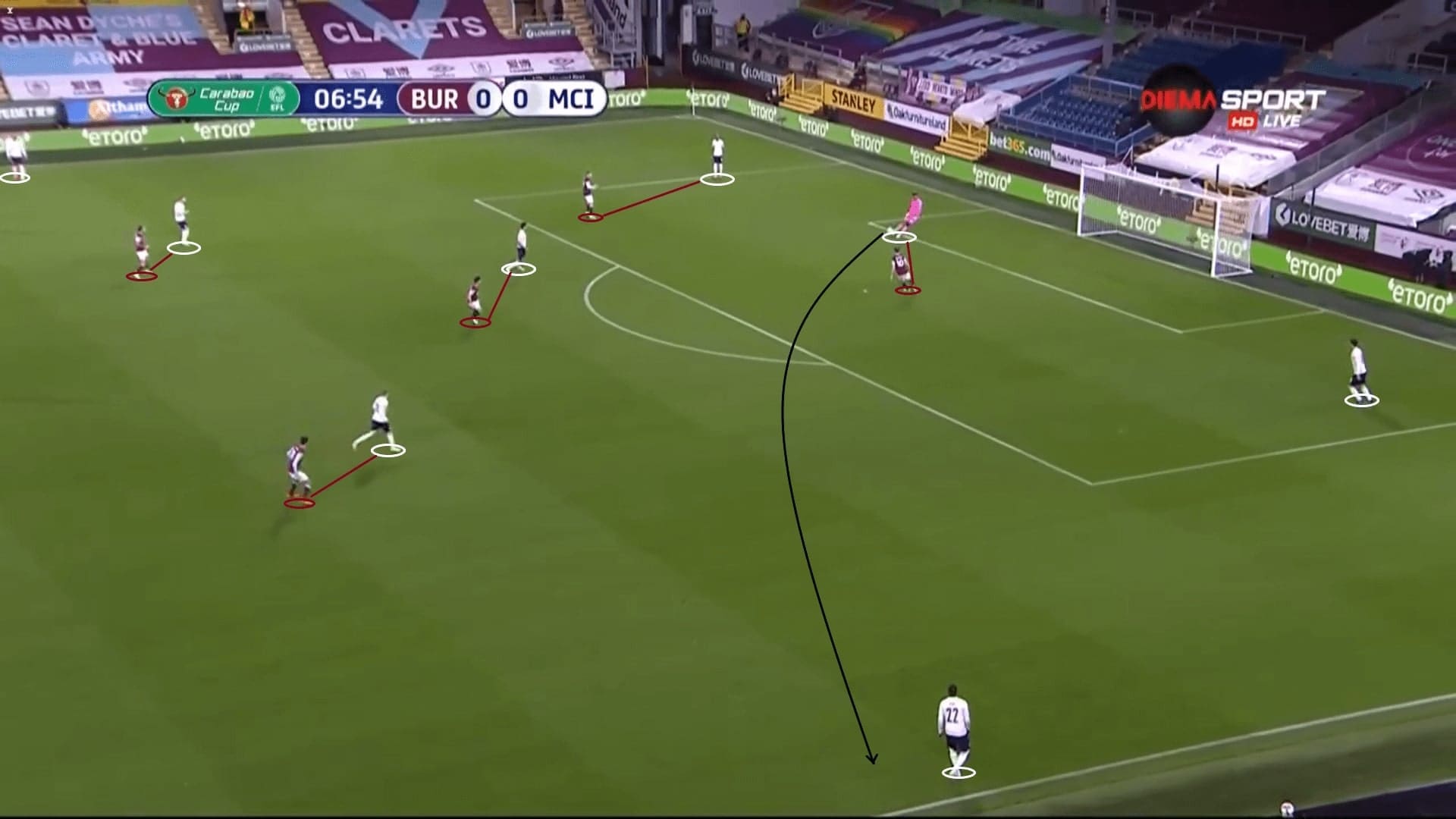
When City played the ball to the full-back, Burnley players had to adjust the positionings to look for a re-press. However, the distances to travel were too large, hence, it was difficult to cover the new targets on time. The Clarets failed to control Rodri, who became the player helping City to reach spaces behind the midfield.
In this example, Mendy passed to Rodri. The Spanish international was very clear on his duty, not even considering a lateral pass or a backward pass. He knew the forward pass must be played and teammates were there, therefore, using his weaker foot to execute. The marker was too late to engage Rodri.
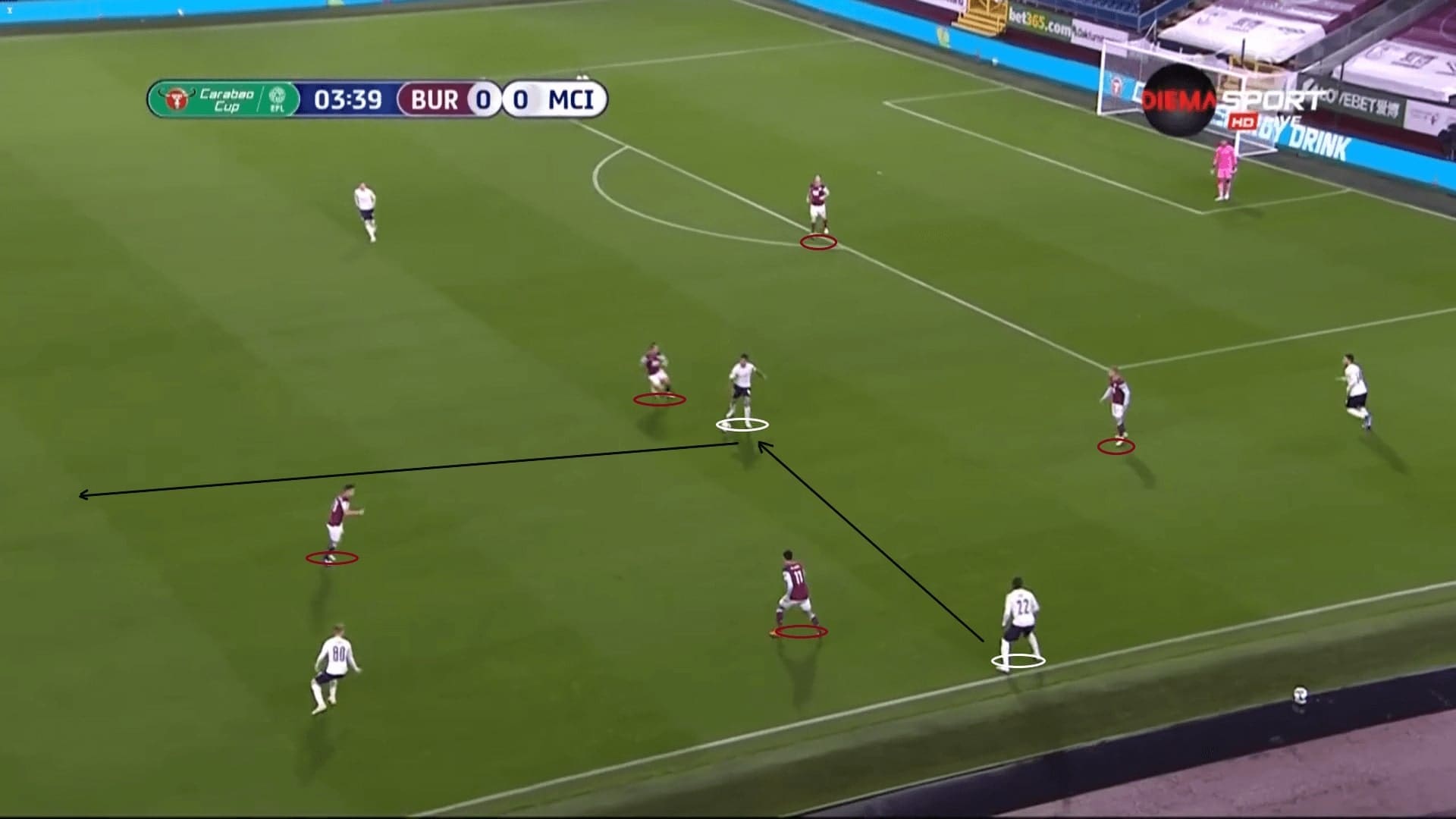
Below is another example that shows City exploiting spaces behind the midfield, as well as the defensive limitations of Burnley. Dyche wanted his full-backs to step out early, for the sake of controlling Torres and Mahrez. However, the others were vulnerable to protect spaces around the full-backs, where City always progressed in those areas.
Here, Dwight McNeil was late to tuck inside and maintain compactness. Players at the frontline were not aggressive enough to attack the ball, leaving Fernandinho to pass. The positioning of Ashley Westwood was awkward, as his duty was duplicated with Charlie Taylor, who aggressively followed Torres. Now, both of them were marking the same player, leaving the central spaces opened.
This was how City escaped from the press. Palmer made the forward run to search for offensive depth, disrupting the backline. Meanwhile, Sterling dropped as a free player to receive the lofted ball from Fernandinho. Given the dynamic and reversed movements of front players, the receiver could often turn without an opponent sticking at his back.
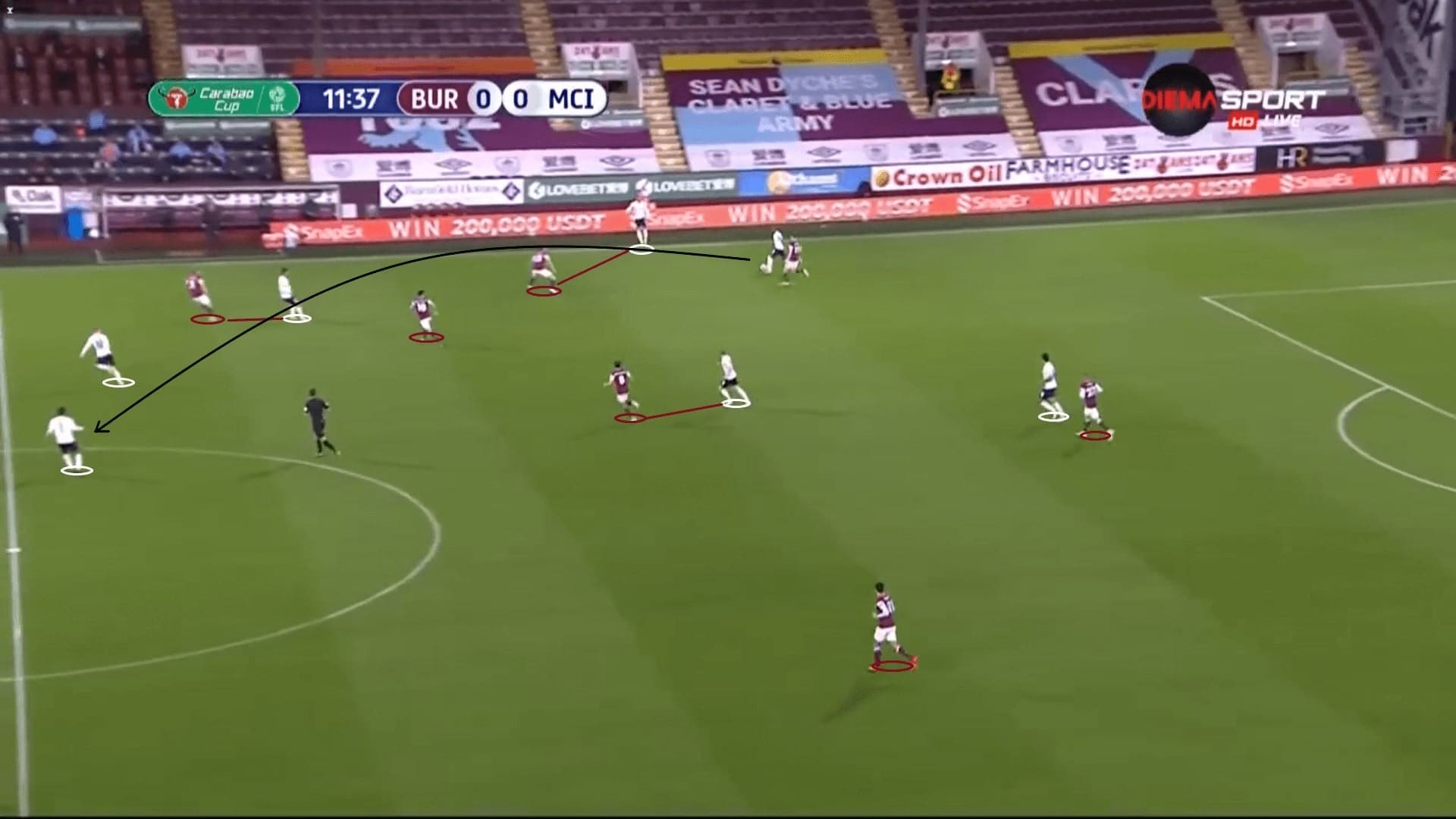
In the second half, the context was slightly different, with Burnley defending deeper. A slight tweak was the positioning of Sterling, who operated as a “false-9”, moving into wide areas. City were able to create an overloaded side on the left, including passing triangles to improve player proximities. We show the situation with the below image.
To compensate for the drop of Sterling, Palmer would push to the highest point of the attack. Sometimes even Mahrez would join the strong side to overload the opponent, which also helped City to regain the ball during the counter-press.
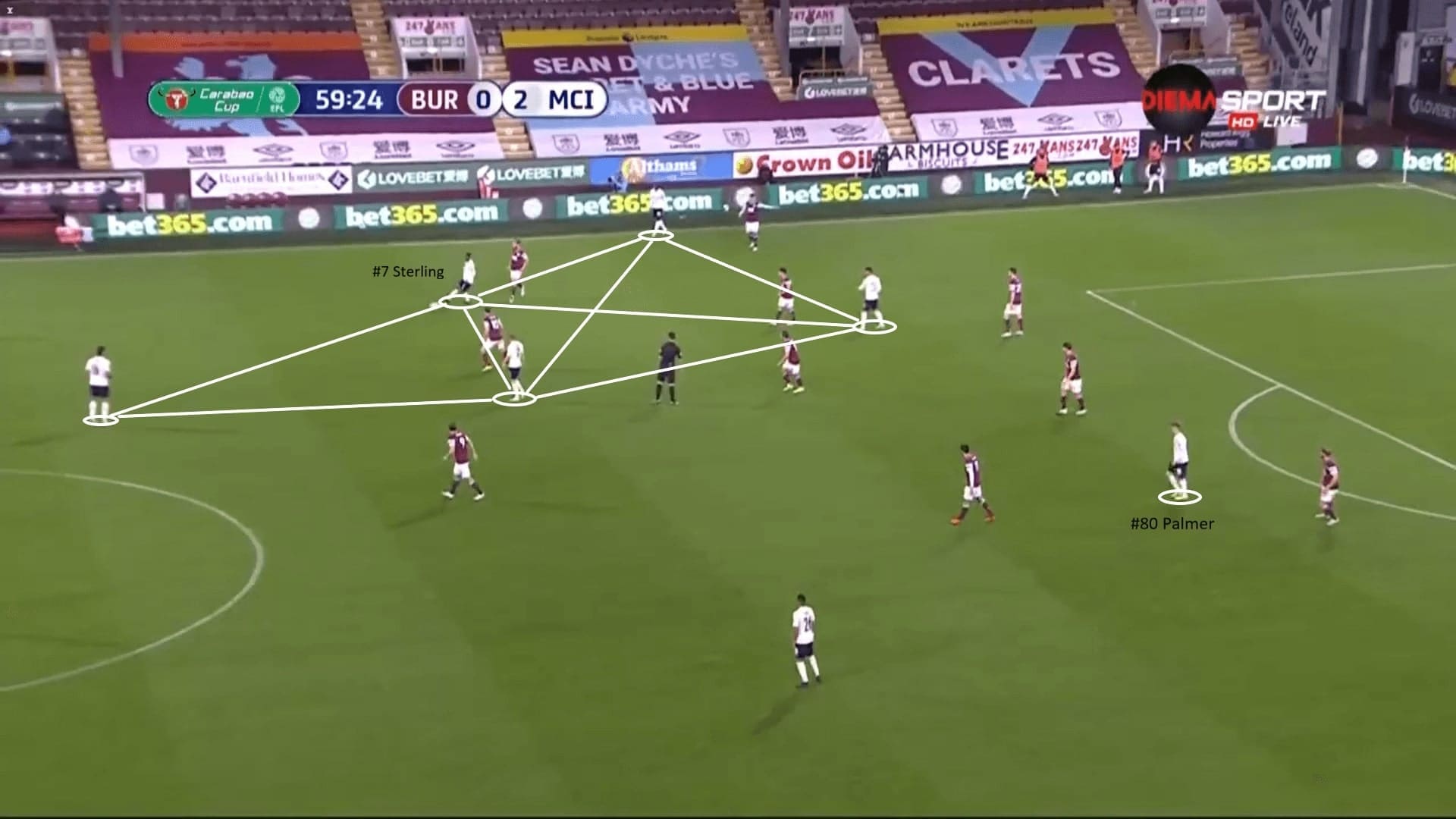
Chances creation in the final third
Against a midblock, Pep and his coaching staff also have a good plan to demolish the Burnley defence. In this game, with Mendy playing as the left-back, the team had the flexibility to choose the way to attack the opponent. Once again, the French international has proved his ability to attack the wide zone, allowing the winger to operate narrowly.
The main point of the attack was to avoid verticality for passes into the final third. This game, City intended to develop the attack on the left flank, relying on Aymeric Laporte to carry the ball over the first line. Then, the centre-back would pass diagonally to find Mendy, instead of playing to the centre. This arrangement has multiple benefits.
Firstly, the pass to Mendy could comfortably reach the receiver’s front foot, as shown in the below image. Passing to Torres or Mahrez, who initially stayed at the half-spaces, the receiver closed the body and this was a trap of Burnley. The Clarets were strong to press from the blindside, so the wide pass could avoid the pressing trigger. Instead, the opponents were forced to adjust instead of anticipating.
For Walker, he could tuck inside in case Palmer or De Bruyne joined the attack. The City shape varied across a 3-2-5 or a 2-3-5 since the ball progressor needed to bring the ball forward.
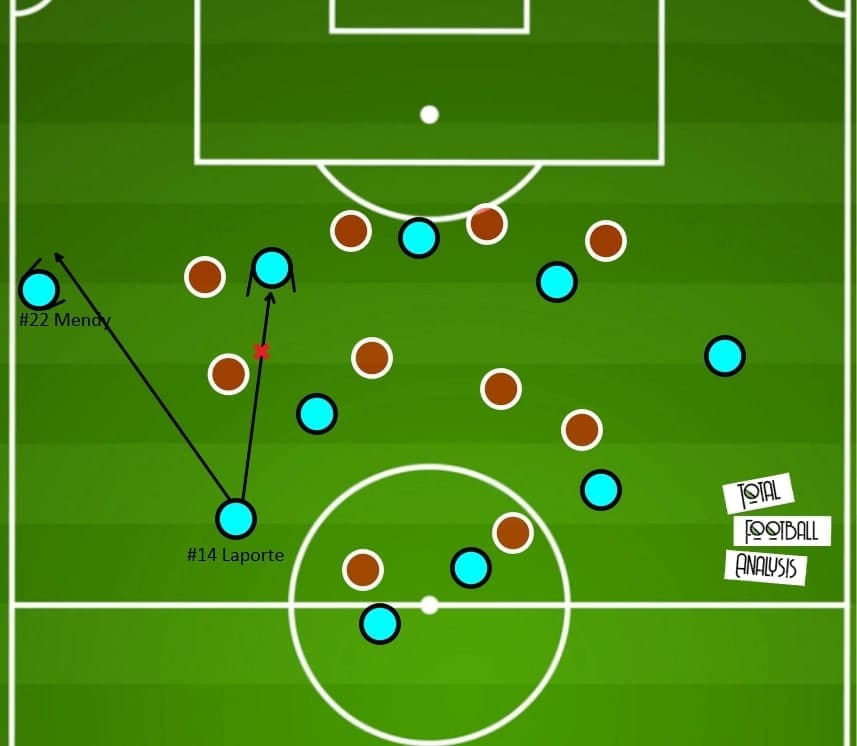
One of the unique strengths of Mendy was his ability to find the central passing lane. Not many left-backs in Europe possessed this skillset. If functioning properly, this was a huge asset to City.
When Laporte played the ball wide, the central attackers never hesitated to run past the Burnley midfield. This would eventually make themselves available between the lines, at the centre or half-spaces. Mendy, instead of putting the ball into zone 16.5, mostly played the ball centrally to the runners, including the below example.
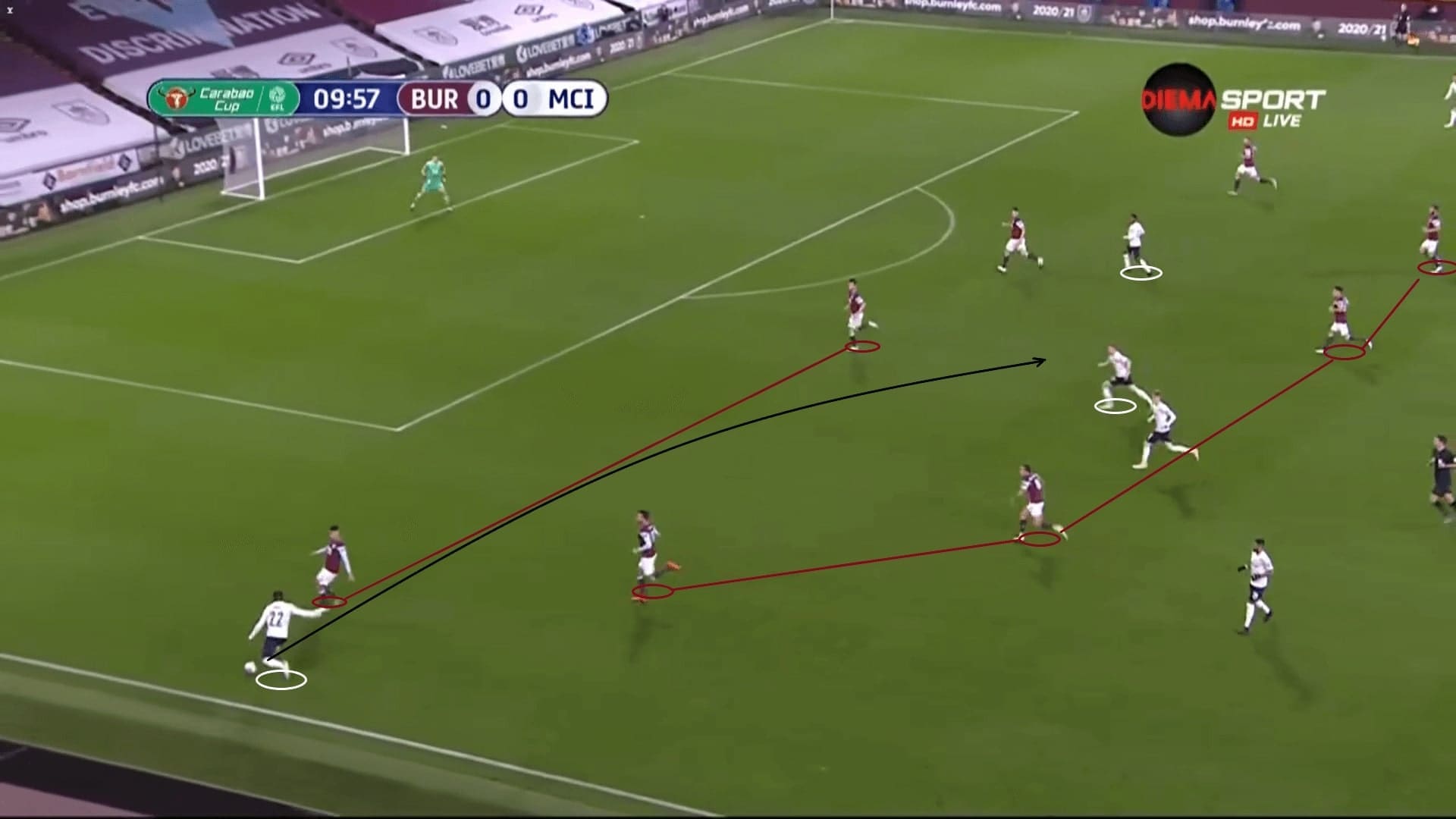
Mendy had a good game by playing these passes. In his 13 passes into the final third, a huge proportion was this type of passes that accessed the centre. Or, when the left-winger supported by inside-out runners, Mendy was also quick to bring the ball into the half-spaces, forcing the defenders to respond.
Below is the final third pass map of Mendy, the point was to show the directions of his passes – those balls to the centre were difficult to defend. In the above image, even Matthew Lowton seems to close the angle already, Mendy still found the passing lane and play the ball out.
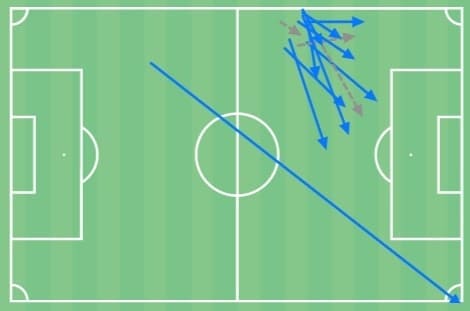
Apart from transitions, City had a lot of chances by running through the half-spaces. Some occasions were attributed to the wide positionings of Mendy, who pulled the right-back out, enlarging that horizontal gap between the Lowton and Long.
Sometimes Burley were caught ball watching, or set a failed offside trap. For example, this one from Torres was onside because Taylor and Lowton were caught. Long was too late to react, while McNeil just expected his teammate to defend. Burnley players were a bit unclear on defending these runs given the zonal system they adapted.
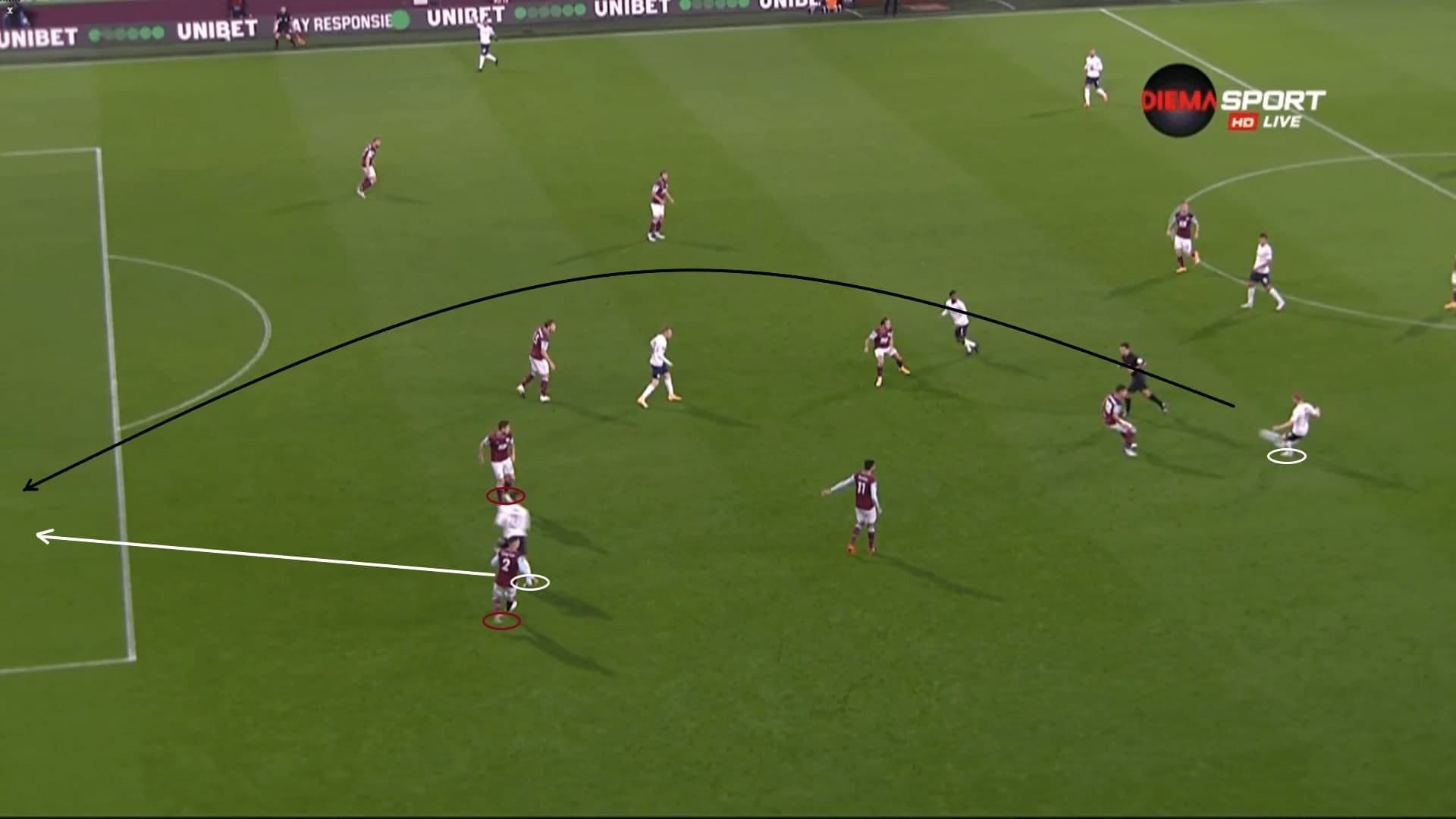
Underlying issues at the defence
Throughout the game, Burnley did not have many chances. Their offensive organisation relied on long balls to progress, but sometimes they exploited issues of City to reach advanced areas. It seems the likes of Torres and Palmer were yet to fully understand the defending system of the team, such as how to curve the runs when pressing.
When pressing in a 4-1-4-1 or a 4-2-4, City’s central areas left exposed because of the relatively deep back four. Spaces were available around Rodri, but too large for the Spanish midfielder to cover. At those moments, Rodri struggled to cope with the situation just like the Leicester game.
Part of the issue was the light pressure from the frontline, as City place less pressure on the ball after two goals up. When Burnley accessed the centre liked the below example, the midfield was lost. The gap between Palmer and Rodri was too large to defend, and the Spanish midfielder was paying attention to the player on his left. Therefore, he did nothing to shut those spaces or press the ball, allowing the opponent to progress at the centre.
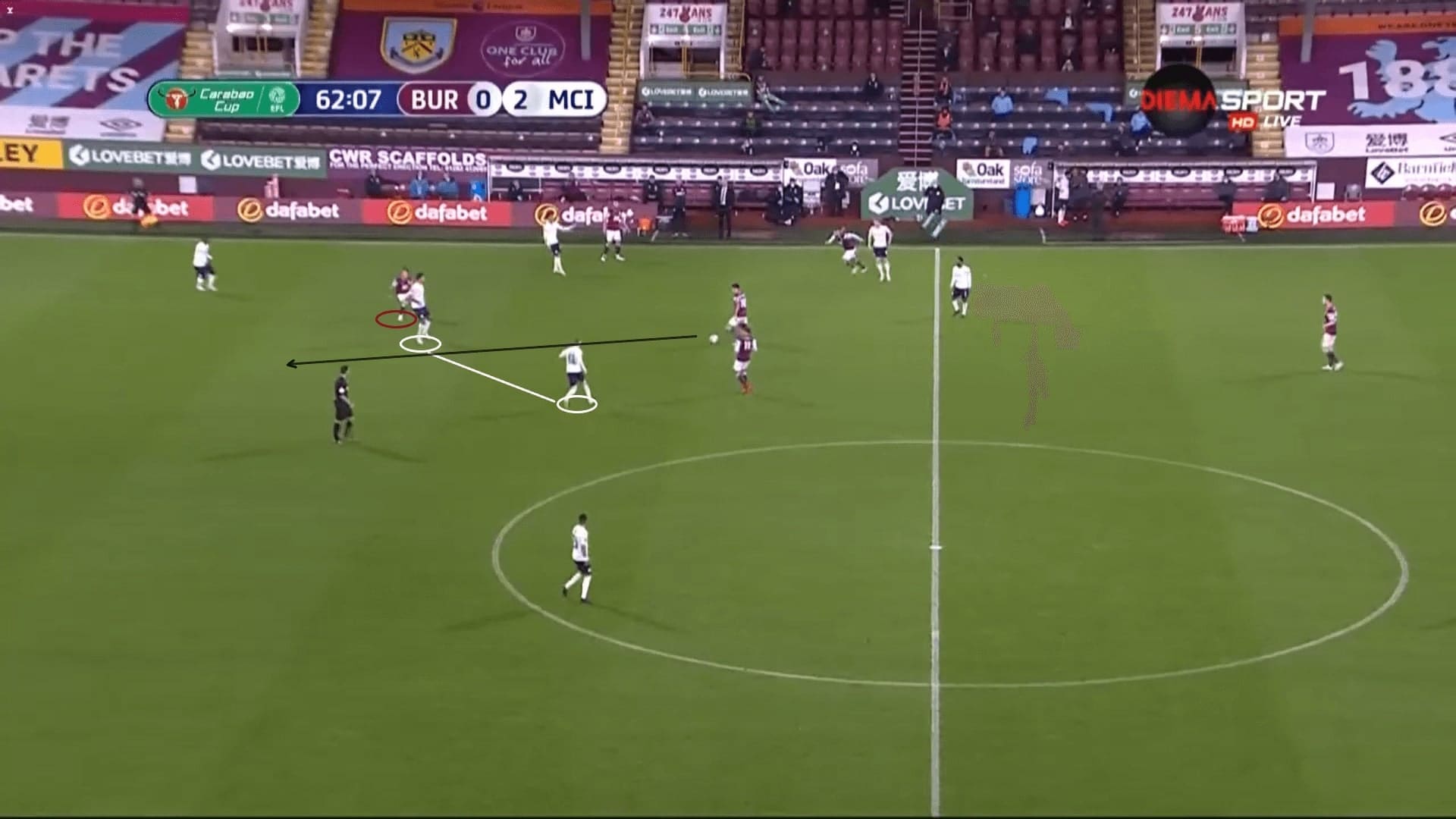
Below is another occasion that demonstrated the potential issue more clearly. City frontline players were not applying enough pressure to force a low-quality long pass. Consequently, the Clarets accurately reached one of the target men in Rodri’s zone, where Burnley enjoyed a 3 v 1 numerical superiority. It was impossible for Rodri to cover all opponent alone, Laporte had to step up and help, but it was late already.
A simple third man combination was used here. Burnley were not particularly good at those quick passing, but this would have been an issue if facing stronger opponents. For example, Mendy was isolated on the left. If the opponent used an “up-back-through” pattern, they could get a 1 v 1 opportunity against Steffen by exploiting the high line of City.
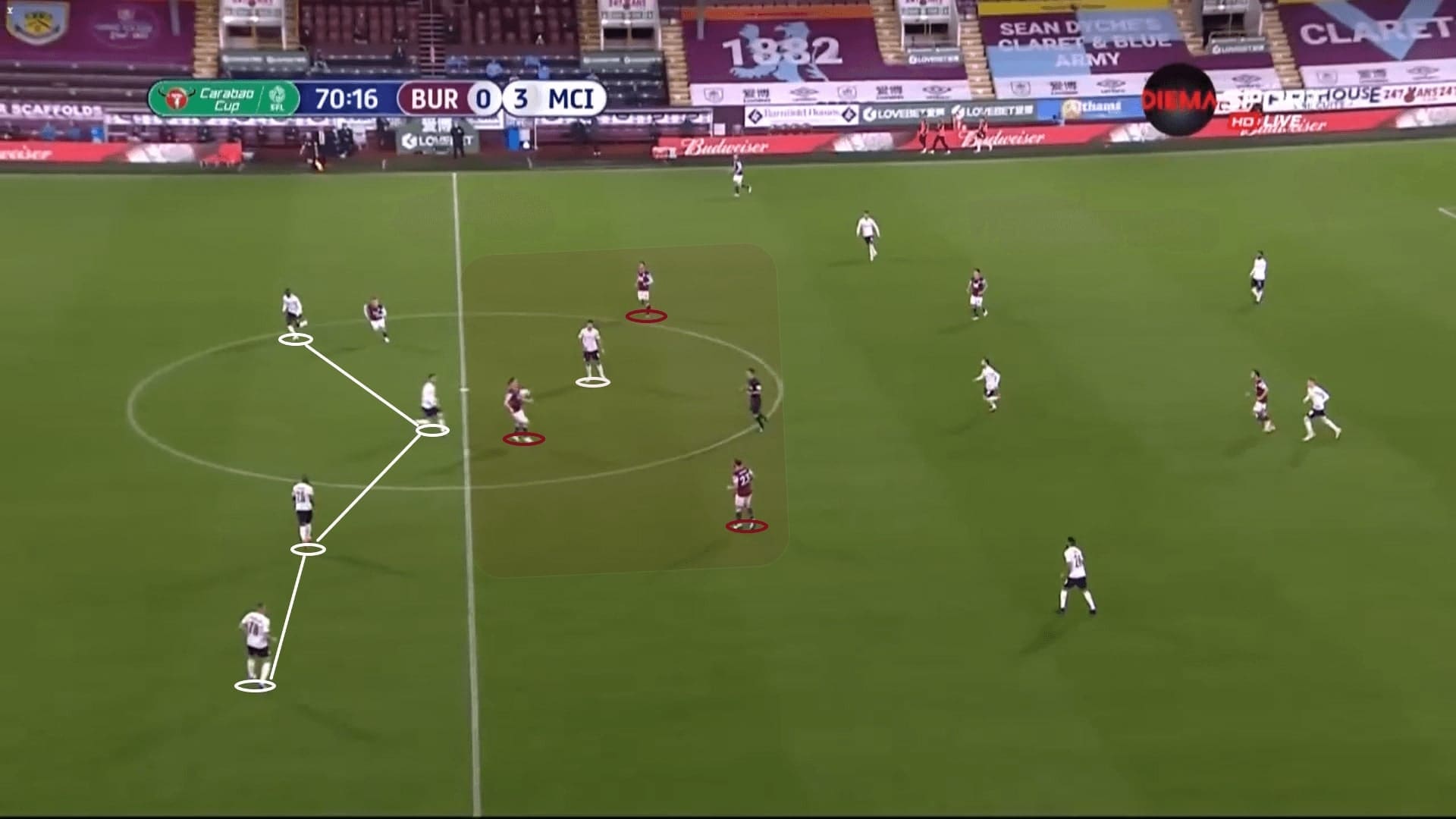
In this game, Burnley were not creating too much threat inside the final third before the game was dead. They were even unable to cross from zone 18 as demonstrated in this crossing chart of the team. Only one successful cross was delivered into dangerous zone, which was made by Taylor.
For the rest of the crosses, they were early or being forced. City defenders did well by delaying or using a deeper line to clear the deliveries.
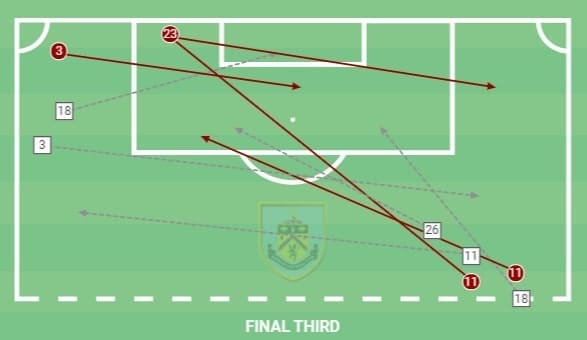
Second ball structures and transitions
The last section of the analysis introduces tactics of the teams in other phases of the game. A huge part to play against Burnley was always picking the second balls, as the Clarets were a very direct team. City players, in general, were weaker in terms of physicality, hence, required a better structure to win the air battles.
Pep’s side usde a 3-1 structure to fight for the second balls, or starting as a close four initially against two strikers. This ensured the absolute numerical superiority around the dropping ball. An important detail was the positioning of the deepest defender, he must stay relatively deeper to the dropping point to clear the ground. For example, Laporte below was doing this job.
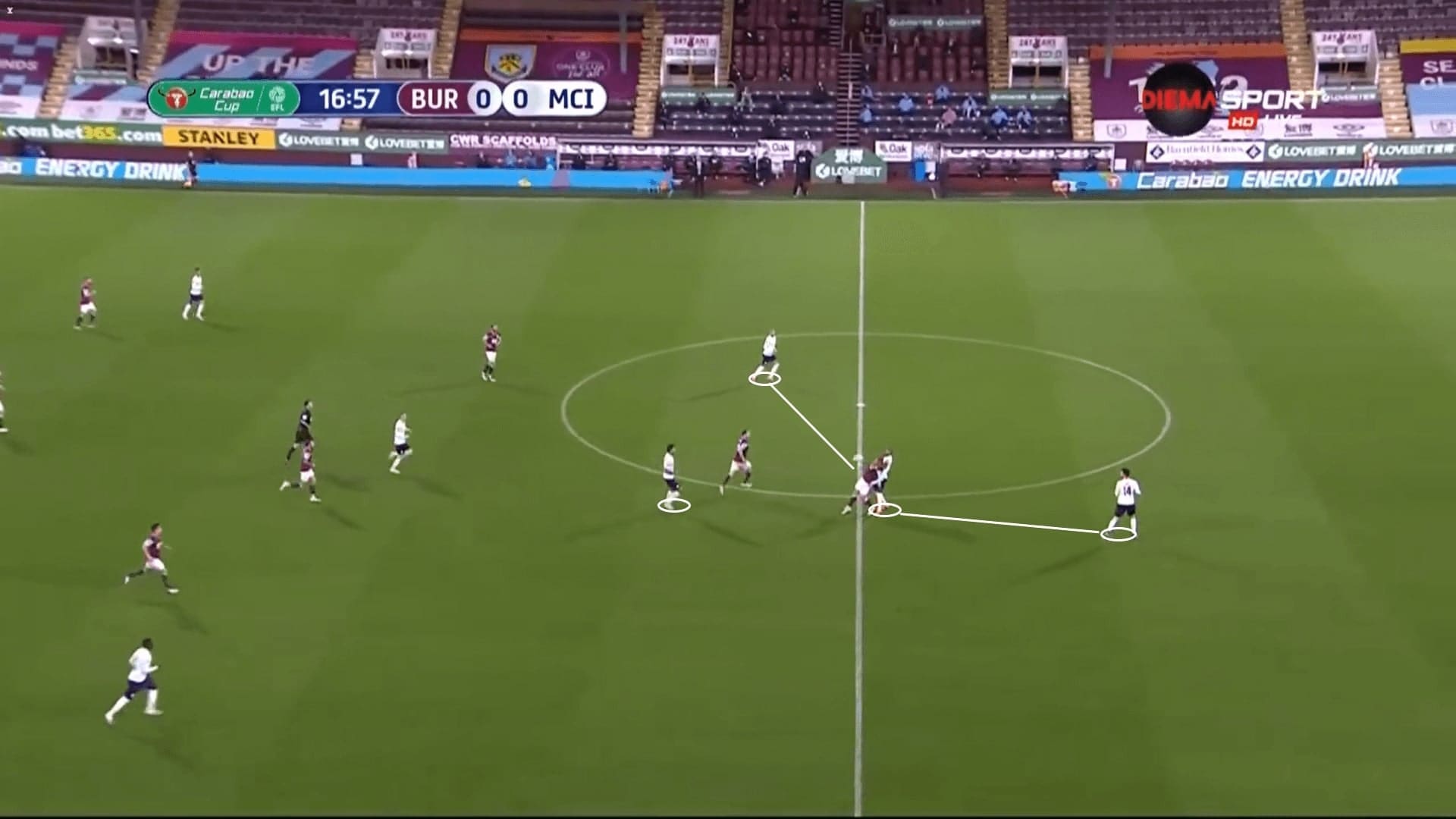
Another example here for more details of the second balls. At least one of the other two advanced midfielders should drop in front of the Burnley midfield for the second balls. In this case, it was Rodri to attempt the aerial duel, who should have enough physical strength and height to deal with most opponents.
The remaining players in the “3” layer were formed by the ball near full-back, plus the central defenders. City tried to overload the area around the dropping ball, and hardly could Burnley capitalise on these direct plays to create opportunities.
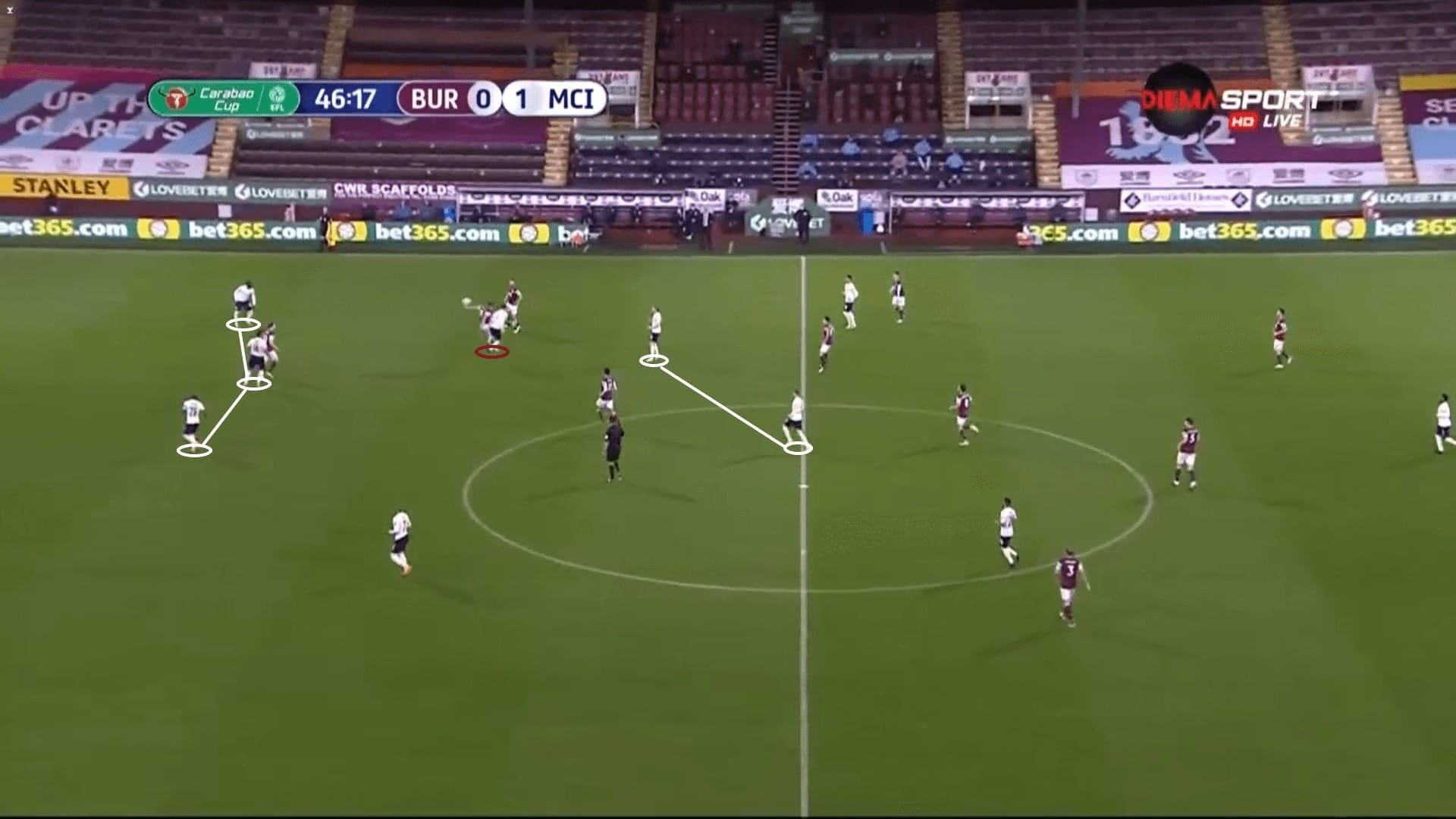
In the offensive transitions, Burnley’s objective was clear too – releasing the strikers behind the defence as quick as possible. The below scenario was an example of it, the high positionings of Walker and Mendy have left the centre-back exposed.
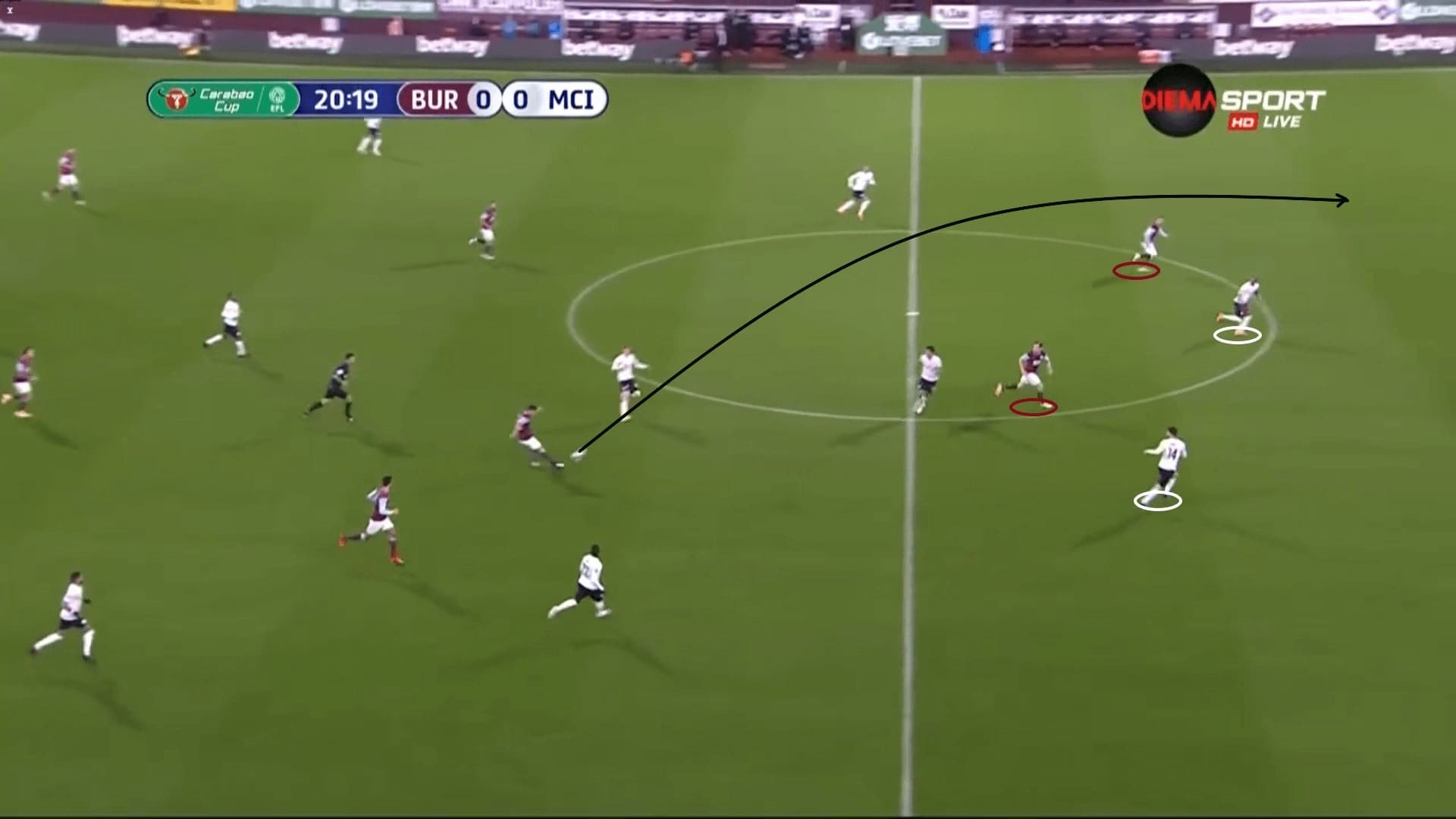
However, unless City gave away the ball because of individual errors, Burnley could not start a counter-attack because of several reasons. The counter-pressing of City were strong given the close proximity of players. Also, the deep defence of Burley limited the probability to release the strikers quickly, Ashley Barnes and Matěj Vydra were yet to reach backline.
Another reason was the offside trap performed by the City rest defence. The defenders were alert to hold a high line, while stepping up to reduce the vertical areas needed to defend. As an example, Laporte suddenly pushed higher when the Burnley players ran past him. Fernandinho was slightly late to react but the attacking players ran too soon. Eventually, the carrier did not pass the ball because of realizing the offside trap.
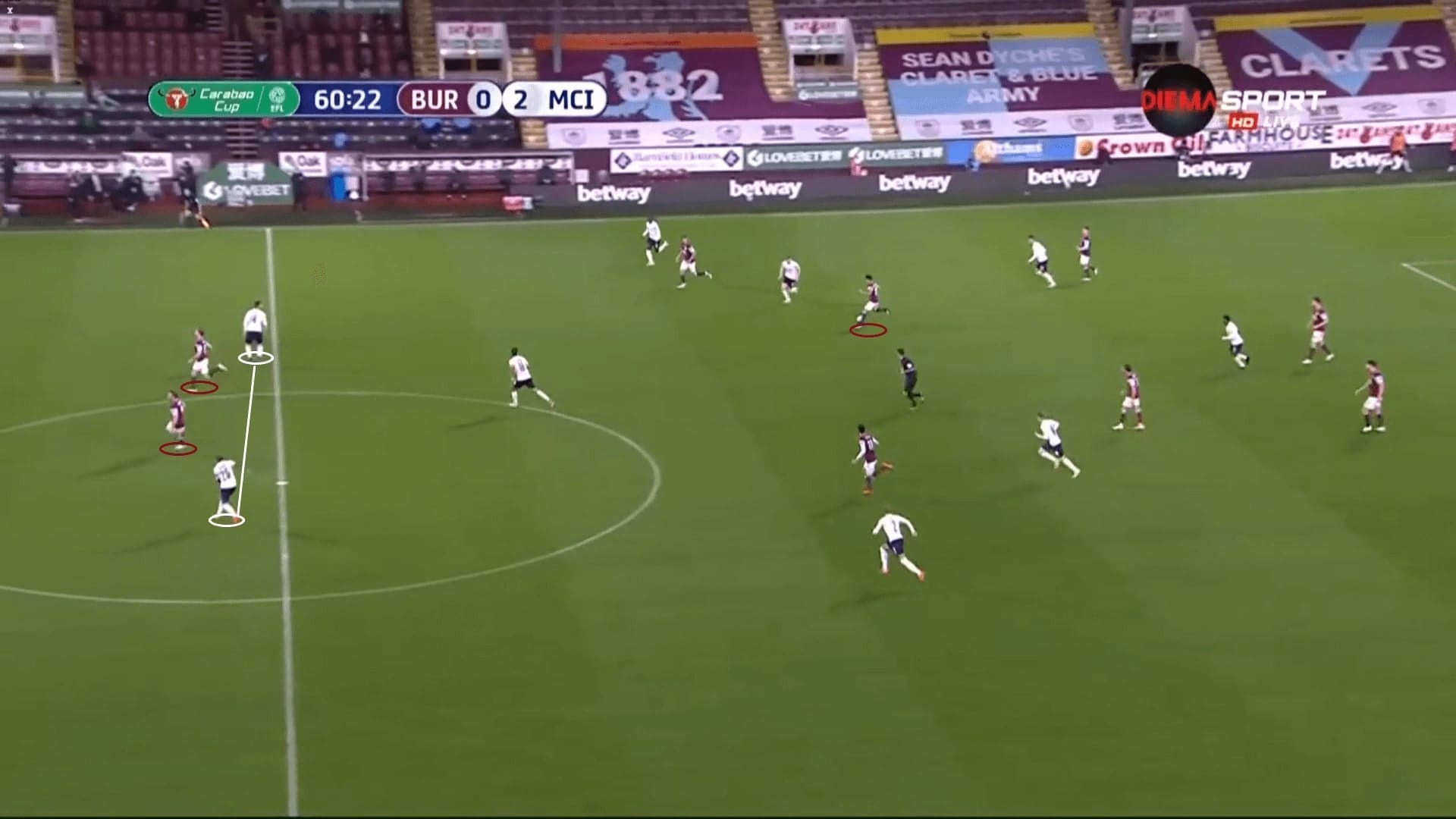
On the contrary, City were a lot more dangerous in the offensive transitions. As Dyche said, the team gave away the ball in “critical positions” and invited City to punish them. Losing several duels at the halfway line have done a lot of harm, City had a lot of chances through these transitions.
Apart from generating opportunities because of great passers such as De Bruyne and Mahrez, City players’ also had a common behaviour to create chances. The runners liked to attack spaces outside of the full-backs, the third goal was a typical example of this. Here, Torres went outside of the centre-back, also on Sterling’s diagonal run that brought Long to the centre. Eventually, the former Valencia man found himself free to shoot assist Sterling.
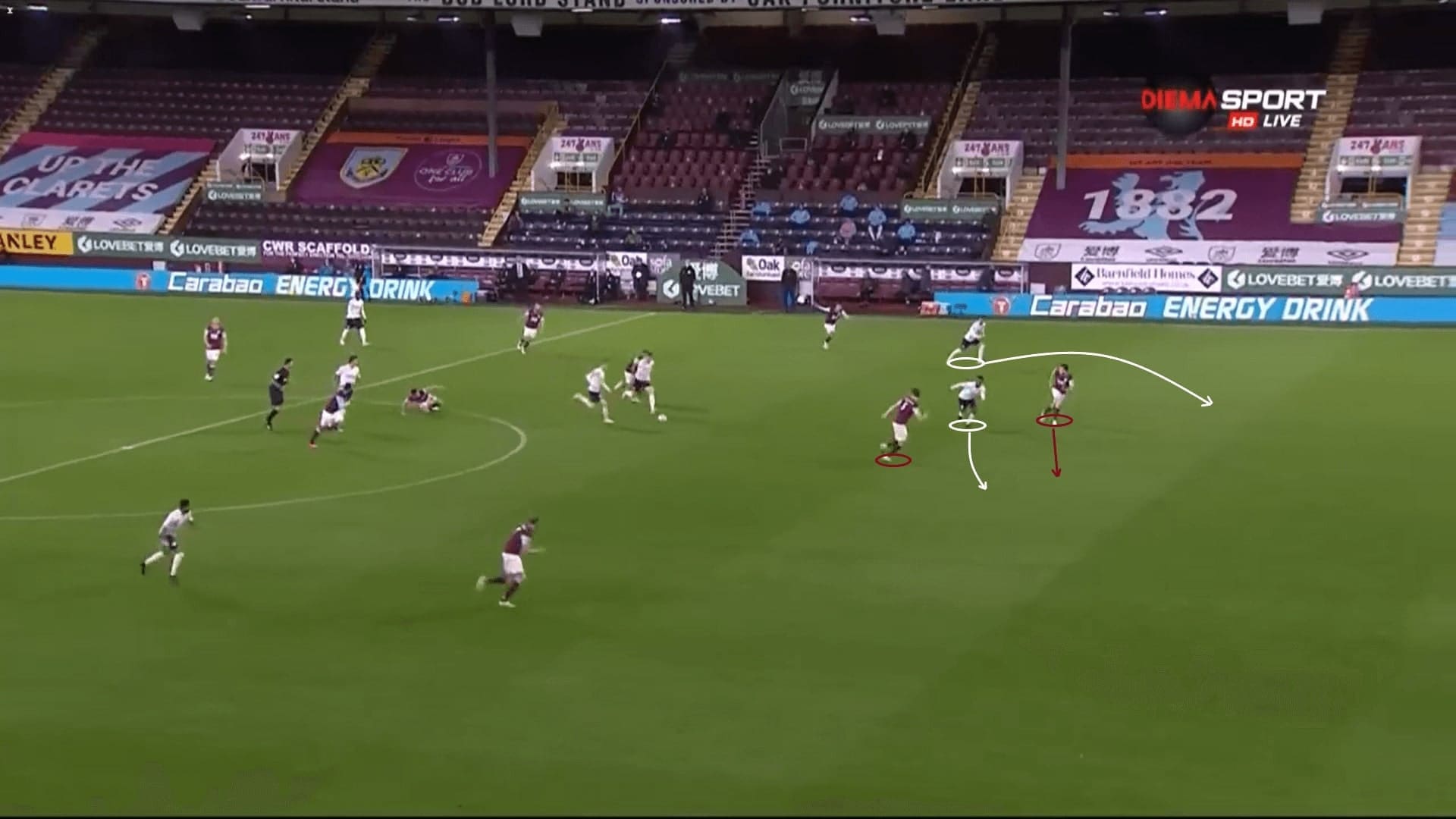
Final remarks
Despite missing a few chances, City did well enough to kill the game by the hour mark. Burnley stopped to play aggressively after Torres sealed the game in the fast break. Pep also rested Rodri, De Bruyne, and Walker for the game against Leeds United on Saturday.
Dyche was delighted to see some of the players such as Barnes and Tarkowski returning to the squad, though he believed a penalty should be awarded. EFL Cup was never the top priority of Burnley, as they focus more on staying in the Premier League next season.





Comments